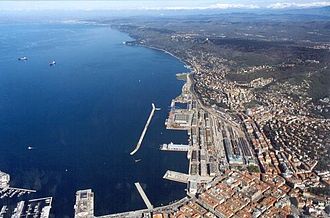Cappuccino
Cappuccino[edit]

A cappuccino is an espresso-based coffee drink that originated in Italy and is traditionally prepared with steamed milk foam. Variations of the drink involve the use of cream instead of milk, and flavoring with cinnamon or chocolate powder. The name "cappuccino" comes from the Capuchin friars, referring to the color of their habits.
History[edit]
The history of cappuccino dates back to the 17th century, with the drink evolving over time. The name "cappuccino" is derived from the Capuchin friars, whose brown robes were similar in color to the drink. The modern cappuccino was developed in Italy after the invention of the espresso machine, which allowed for the creation of espresso coffee and the steaming of milk.

The port city of Trieste played a significant role in the spread of coffee culture in Europe. As a major coffee port, Trieste was instrumental in the development and popularization of coffee drinks, including the cappuccino.
Preparation[edit]
A traditional cappuccino is made with equal parts of espresso, steamed milk, and milk foam. The process begins with the preparation of a shot of espresso, which is then topped with steamed milk and a thick layer of milk foam. The foam acts as an insulator, keeping the drink warm and providing a creamy texture.

The quality of the milk foam is crucial to the cappuccino's texture and taste. The milk is steamed to create microfoam, which is a velvety and smooth foam that blends well with the espresso.
Variations[edit]
There are several variations of the cappuccino, including the "dry" cappuccino, which has more foam and less milk, and the "wet" cappuccino, which has more milk and less foam. Some variations include the addition of flavorings such as cinnamon, chocolate, or vanilla.
Cultural Significance[edit]
Cappuccino is a staple of Italian coffee culture and is traditionally consumed in the morning. It is often enjoyed with a pastry or a light breakfast. The drink has gained international popularity and is now a common offering in coffee shops around the world.

Related Pages[edit]
Ad. Transform your life with W8MD's Budget GLP-1 injections from $75


W8MD offers a medical weight loss program to lose weight in Philadelphia. Our physician-supervised medical weight loss provides:
- Weight loss injections in NYC (generic and brand names):
- Zepbound / Mounjaro, Wegovy / Ozempic, Saxenda
- Most insurances accepted or discounted self-pay rates. We will obtain insurance prior authorizations if needed.
- Generic GLP1 weight loss injections from $75 for the starting dose.
- Also offer prescription weight loss medications including Phentermine, Qsymia, Diethylpropion, Contrave etc.
NYC weight loss doctor appointmentsNYC weight loss doctor appointments
Start your NYC weight loss journey today at our NYC medical weight loss and Philadelphia medical weight loss clinics.
- Call 718-946-5500 to lose weight in NYC or for medical weight loss in Philadelphia 215-676-2334.
- Tags:NYC medical weight loss, Philadelphia lose weight Zepbound NYC, Budget GLP1 weight loss injections, Wegovy Philadelphia, Wegovy NYC, Philadelphia medical weight loss, Brookly weight loss and Wegovy NYC
|
WikiMD's Wellness Encyclopedia |
| Let Food Be Thy Medicine Medicine Thy Food - Hippocrates |
Medical Disclaimer: WikiMD is not a substitute for professional medical advice. The information on WikiMD is provided as an information resource only, may be incorrect, outdated or misleading, and is not to be used or relied on for any diagnostic or treatment purposes. Please consult your health care provider before making any healthcare decisions or for guidance about a specific medical condition. WikiMD expressly disclaims responsibility, and shall have no liability, for any damages, loss, injury, or liability whatsoever suffered as a result of your reliance on the information contained in this site. By visiting this site you agree to the foregoing terms and conditions, which may from time to time be changed or supplemented by WikiMD. If you do not agree to the foregoing terms and conditions, you should not enter or use this site. See full disclaimer.
Credits:Most images are courtesy of Wikimedia commons, and templates, categories Wikipedia, licensed under CC BY SA or similar.
Translate this page: - East Asian
中文,
日本,
한국어,
South Asian
हिन्दी,
தமிழ்,
తెలుగు,
Urdu,
ಕನ್ನಡ,
Southeast Asian
Indonesian,
Vietnamese,
Thai,
မြန်မာဘာသာ,
বাংলা
European
español,
Deutsch,
français,
Greek,
português do Brasil,
polski,
română,
русский,
Nederlands,
norsk,
svenska,
suomi,
Italian
Middle Eastern & African
عربى,
Turkish,
Persian,
Hebrew,
Afrikaans,
isiZulu,
Kiswahili,
Other
Bulgarian,
Hungarian,
Czech,
Swedish,
മലയാളം,
मराठी,
ਪੰਜਾਬੀ,
ગુજરાતી,
Portuguese,
Ukrainian